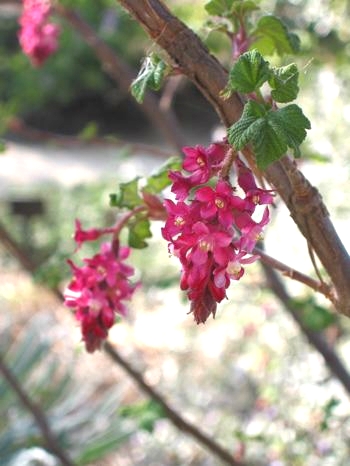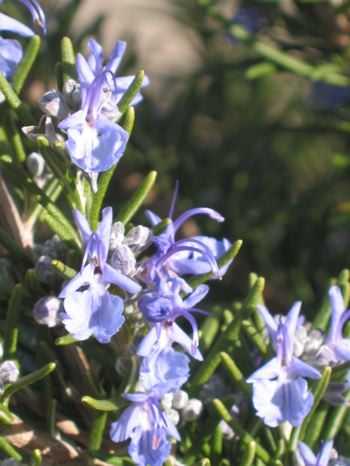Dealing with mud.
The UC Davis Arboretum in winter
Written for the Davis Enterprise, February 28, 2008
 You may think of currants as the small raisins in holiday desserts. But true currants are in the genus Ribes, and include many winter-blooming California native shrubs. This variety of the Chaparral currant (Ribes malvaceum) is called Montara Rose. Ribes flowers attract hummingbirds, and the tiny tart fruit attracts songbirds.
You may think of currants as the small raisins in holiday desserts. But true currants are in the genus Ribes, and include many winter-blooming California native shrubs. This variety of the Chaparral currant (Ribes malvaceum) is called Montara Rose. Ribes flowers attract hummingbirds, and the tiny tart fruit attracts songbirds.
One of the first sure signs of spring is when gardeners wander into garden centers looking
for something, anything, to brighten their yards. Trees and shrubs are bare, herbaceous
perennials are dormant, and days of fog and rain have left our yards mostly muddy. A few
bags of bark make the paths passable again, but there isn't much to look at.
A quick way to brighten the garden is to pop in some winter annuals. Perhaps the brightest
flowers, with the broadest range of color, are English primroses (Primula polyanthus).
Though they return to bloom again in subsequent years in mild-summer areas, primroses are
treated as annuals in the Sacramento Valley. Other cheery winter annuals include pansies,
violas, snapdragons, and – one of my favorites – Paludosum daisy. Planted now, all of these
annuals will bloom freely into May.
Low-growing evergreen shrubs and winter-blooming perennials perk up the garden in
February. Looking for ideas? Take a stroll in the UC Davis Arboretum! There is inspiration to be
found in the 18 collections and gardens scattered along the miles of paths. Keep in mind
that if you see it growing in the arboretum, you can probably grow it in your yard. On a recent
walk during a break in the storms I found many shrubs and perennials in flower.
The Mary Wattis Brown Garden of California Native Plants
Located about mid-point in the Arboretum, this garden really comes into its own as our native
plants bloom through the spring. The large evergreen shrubs, of course, are proving their
value. There are lingering berries of Toyon (Heteromeles) and Coffeeberry (Rhamnus californica). Oregon grape (Mahonia) is showing off shiny clean leaves, bronze new growth,
and bright yellow winter flowers. The mountain lilacs (Ceanothus) are just starting to bloom,
with fragrant blue flowers through April. I saw the first glimpses of magenta on the western
redbuds (Cercis occidentalis); mark your calendar to take in their spectacular display in mid-
March to early April.
As I stood admiring the subtle flowers of native currants (Ribes), the high twitter of
hummingbirds reminded me that many of our native plants draw birds and beneficial insects
into the garden.
Among perennials blooming now, hummingbirds love the native species of Coral bells
(Heuchera) which are showing their first rosy spikes. The foliage of all Heucheras is attractive
enough year-around that plant breeders have introduced many hybrids with golden, bronze,
purple, and variegated leaves.
Evergreen low shrubs? Look no further than the Salvias: the many species and hybrids in this
group of plants provide long blossom season, attract hummingbirds, and include some very
tough garden plants. California native Salvias bloom in the spring to take advantage of mild
temperatures and winter rains. These shrubby sages all have clean, attractive leaves with
pungent fragrance. Salvia 'Bee's Bliss' is a hybrid between two native species, just coming into
bloom.
Other suitable California native Salvias for valley gardens include:
White sage (S. apiana) with intensely aromatic leaves;
Black sage (S. mellifera) with dark olive-green leaves;
Hummingbird or Pitcher sage (S. spathacea), which has bold, crinkly leaves and big whorls of
magenta flowers.
The Mediterranean Collection
Further west, less intensively planted, this area has broader vistas around the second wide
portion ("scenic lagoon" according to the Arboretum web site) of Putah Creek. In winter, the
star of this collection is Rosmarinus officinalis: plain old Rosemary never looked so good!
There are several varieties planted en masse, and one big virtue of rosemary is that it blooms
heavily in the winter with flowers ranging from pale blue to vivid violet. There is even a white-
flowered type. Milder-flavored varieties are generally preferred for the kitchen herb, but any can
be used: just squeeze a leaf to test the intensity of fragrance and flavor.
Rosemary can be divided into two categories based on growth habit: trailing and upright.
Trailing varieties are most common in the nursery trade. Gardeners in more extreme climates
need to know that these prostrate types are more tender, damaged at 20F, but that isn't an
issue here. These types typically grow 1' – 2' high, spreading outward several feet. Irene,
Lockwood de Forest, and Prostratus are good trailers.
 Rosemary (Rosmarinus officinalis) is a plant of many uses: kitchen, garden, and landscape. The winter blooms brighten the pathways of the Mediterranean Collection in the Arboretum. The flowers (shown in closeup) attract honeybees, looking for pollen early in the season, and small songbirds like the cover provided by the fragrant branches.
Rosemary (Rosmarinus officinalis) is a plant of many uses: kitchen, garden, and landscape. The winter blooms brighten the pathways of the Mediterranean Collection in the Arboretum. The flowers (shown in closeup) attract honeybees, looking for pollen early in the season, and small songbirds like the cover provided by the fragrant branches.
The upright varieties are hardier. More important, they can become substantial sized landscape
shrubs to 4' – 6' or more. Tuscan Blue, an upright cultivar, has exceptionally showy flowers and
excellent leaves for roasts and barbecues. Next time you roast a chicken, stuff it with a whole
lemon and two sprigs of Tuscan Blue. Blue Spires is even bigger and upright enough to shear as
a hedge.
Another low evergreen shrub – actually, silver gray – is Bush germander (Teucrium fruticans).
The small lavender-blue flowers resemble rosemary, and the silver foliage contrasts nicely with
rosemary's dark green. Equally tough and even longer-blooming, germander makes a somewhat
informal shrub. Light clipping every few months makes the shrub more compact.
A perennial Euphorbia has naturalized on a nearby slope. Euphorbia characias wulfenii has chartreuse
flowers perched above grey-green leaves. Growers have several new varieties of Euphorbias to provide
gardeners with colorful foliage and interesting flowers, and all are notable for drought tolerance. Note
that this one has naturalized; that is nursery-speak for "has spread beyond where it was planted." Some
Euphorbias can be invasive, while other garden varieties are well-behaved.
The Ruth Risdon Storer Garden
and the Carolee Shields White Flower Garden.
These adjoining gardens at the west end of the Arboretum are a gardener's year-round resource for
plant ideas. There is always something with color to admire and consider for your own yard.
As you enter the Storer garden in February you are greeted by cheerful dwarf Narcissus Tete-a-Tete.
Clean low succulents line the paths, and the grey foliage of lavender (Lavandula) looks good no matter
the season.
The two most visible shrubs blooming right now in the Shields garden could not be more different in
regard to garden tolerance.
Flowering quince (Chaenomeles) is tough: tolerant of nearly any watering regimen, sun or shade, and
indifferent about soil type. This deciduous shrub is the first to bloom in the spring, with flowers in pink,
red, coral, and white. So, though bare in winter, the early blooms mark the beginning of spring for us.
One variety (Toyo Nishiki) even has pink, red, and white flowers all on the same plant.
Lovely and easy. But my guests were drawn to the intense fragrance of the nearby Daphne odora.
There are two of the pure white form in the Shields garden, and the intense lemony scent reached us
many yards away. "Is this hard to grow?" they asked. No, it is just easy to kill. Daphne requires perfect
drainage and is very susceptible to fungi that attack the roots and crown if you overwater it in the
summer.
Winter-blooming perennials? In the Storer garden, winter-blooming bergenia (B. crassifolia) and Lenten
rose (Helleborus orientalis) provide reliable winter color. Both are easy, adaptable, and long-lived, and
both can tolerate partial to full shade. While other herbaceous perennials are just poking up from their
winter dormancy, these two – along with our fall-planted bulbs and seasonal annuals – have attractive
foliage and showy flowers even after weeks of fog and rain.
For more information about the UC Davis Arboretum, including a printable map showing the location of
the gardens and collections, visit their web site at
http://arboretum.ucdavis.edu/
© 2004 Don Shor, Redwood Barn Nursery, Inc., 1607 Fifth Street, Davis, Ca 95616
www.redwoodbarn.com
Feel free to copy and distribute this article with attribution to this author.
Click here for Don's other Davis Enterprise articles
